#anthony scooter teague
Text

Anthony Scooter Teague as Bud Frump in How to Succeed in Business Without Really Trying (1967). Tony was born in Jacksboro, Texas, and had 11 acting credits, from a 1958 episode of The Danny Thomas Show, to The Barefoot Executive (1971). His other notable credits include West Side Story (as Big Deal) and The Trouble with Girls (with Elvis Presley). He died of cancer at the age of 49.
4 notes
·
View notes
Text
WATCHLIST 2021: How to Succeed in Business Without Really Trying

#movie watchlist#How to Succeed in Business Without Really Trying#robert morse#michele lee#maureen arthur#anthony 'scooter' teague
1 note
·
View note
Photo
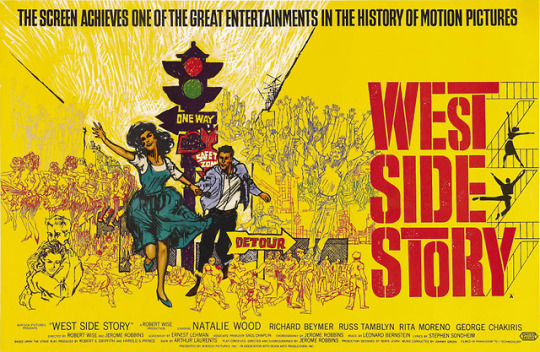
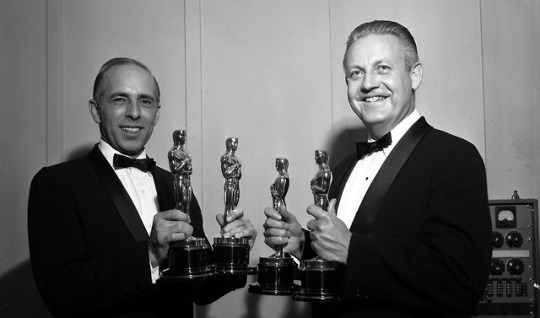
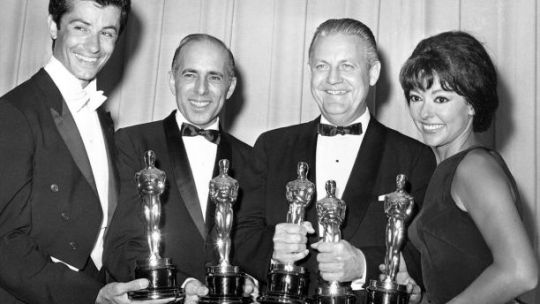


West Side Story is set in the mid 1950's, when many Puerto Ricans moved to NYC. The Jets are from Manhattan. They have ruled their "turf" for years, after defeating the Emeralds. The Sharks are from Puerto Rico. They have just recently come to NY, and want a "turf" of their own.
Who wrote West Side Story:
West Side Story is based on a conception by Jerome Robbins.
Book by Arthur Laurents
Lyrics by Stephen Sondheim
Music by Leonard Bernstein
Entire Original Production Directed and Choreographed by Jerome Robbins
Orchestrations by Leonard Bernstein with Sid Ramin and Irwin Kostal
Film Version:
Directed by: Robert Wise & Jerome Robbins
Screenplay: Ernest Lehman
Choreography: Jerome Robbins
When was West Side Story written:
Jerome Robbins' proposed the idea for writing a musical based on Romeo and Juliet to Leonard Bernstein in January of 1949 (working title: East Side Story, set in the slums at the coincidence of Easter-Passover celebrations). In August of 1955, a meeting with Arthur Laurents produced another idea -- two teen-age gangs as the warring factions, one of them newly-arrived Puerto Ricans, the other self-styled "Americans." In November, 1955 Stephen Sondheim joined the project as lyricist. A year and a half later, rehearsals began for the Broadway premiere of West Side Story.
DIRECTED BY
Jerome Robbins
Robert Wise
WRITING CREDITS
Lehman ...(screenplay)
Arthur Laurents ...(book)
Jerome Robbins ...(play)
William Shakespeare ...(play) (uncredited)
CAST (IN CREDITS ORDER)
Natalie Wood ... Maria
Richard Beymer ... Tony
Russ Tamblyn ... Riff
Rita Moreno ... Anita
George Chakiris ... Bernardo
Simon Oakland ... Schrank
Ned Glass ... Doc
William Bramley ... Krupke
Tucker Smith ... Ice
Tony Mordente ... Action
David Winters ... A-rab
Eliot Feld ... Baby John
Bert Michaels ... Snowboy
David Bean ... Tiger
Robert Banas ... Joyboy
Anthony 'Scooter' Teague ... Big Deal (as Scooter Teague)
Harvey Evans ... Mouthpiece (as Harvey Hohnecker)
Tommy Abbott ... Gee-Tar
Susan Oakes ... Anybodys
Gina Trikonis ... Graziella
Carole D'Andrea ... Velma
Jose De Vega ... Chino
Jay Norman ... Pepe
Gus Trikonis ... Indio
Eddie Verso ... Juano
Jaime Rogers ... Loco
Larry Roquemore ... Rocco
Robert E. Thompson ... Luis (as Robert Thompson)
Nick Navarro ... Toro (as Nick Covacevich)
Rudy Del Campo ... Del Campo
Andre Tayir ... Chile
Yvonne Wilder ... Consuelo (as Yvonne Othon)
Suzie Kaye ... Rosalia
Joanne Miya ... Francisca
REST OF CAST LISTED ALPHABETICALLY:
John Astin ... Glad Hand (uncredited)
Francesca Bellini ... Debby, Snowboy's Girlfriend (uncredited)
Elaine Joyce ... Hotsie, Tiger's Girlfriend (uncredited)
Priscilla Lopez ... Child Extra (uncredited)
Marni Nixon ... Playback vocalist for Natalie Wood (uncredited)
Olivia Perez ... Margarita, Rocco's Girlfriend (uncredited)
Lou Ruggiero ... Police Officer #3 (uncredited)
Penny Santon ... Madam Lucia (uncredited)
Luci Stone ... Estella, Loco's Girlfriend (uncredited)
Pat Tribble ... Minnie, Baby John's Girlfriend (uncredited)
Gary Troy ... Dancer (uncredited)
Produced by Saul Chaplin ...associate producer
Walter Mirisch ...executive producer (uncredited)
Robert Wise ...producer (uncredited)
MUSIC BY
Leonard Bernstein
Irwin Kostal ...(uncredited)
CINEMATOGRAPHY BY
Daniel L. Fapp ...director of photography
FILM EDITING BY
Thomas Stanford ...film editor
PRODUCTION DESIGN BY
Boris Leven ...(production designed by)
SET DECORATION BY
Victor A. Gangelin ...(as Victor Gangelin)
COSTUME DESIGN BY
Irene Sharaff ...(costume designed by)
MAKEUP DEPARTMENT
Emile LaVigne ...makeup (as Emile La Vigne)
Alice Monte ...hairdresser
PRODUCTION MANAGEMENT
Allen K. Wood ...production manager
Hubert Fröhlich ...production manager (uncredited)
SECOND UNIT DIRECTOR OR ASSISTANT DIRECTOR
Robert E. Relyea ...assistant director
Jerome M. Siegel ...second assistant director
Ridgeway Callow ...assistant director (uncredited)
ART DEPARTMENT
Sam Gordon ...property
Maurice Zuberano ...production artist (as M. Zuberano)
Leon Harris ...production illustrator (uncredited)
William Maldonado ...construction coordinator (uncredited)
SOUND DEPARTMENT
Fred Lau ...sound
Gilbert D. Marchant ...sound editor
Murray Spivack ...sound
Vinton Vernon ...sound
Richard Gramaglia ...sound mixer (uncredited)
Fred Hynes ...sound recording supervisor (uncredited)
Gordon Sawyer ...sound supervisor (uncredited)
VISUAL EFFECTS BY
Saul Bass ...visual consultant
Linwood G. Dunn ...photographic effects (as Linwood Dunn)
STUNTS
Eli Bo Jack Blackfeather ...stunts (uncredited)
CAMERA AND ELECTRICAL DEPARTMENT
Linwood G. Dunn ...title photographer (uncredited)
John Finger ...camera operator: title sequence (uncredited)
Ernst Haas ...still photographer (uncredited)
Jerome H. Klein ...electrician (uncredited)
Louis Kulsey ...dolly grip: title sequence (uncredited)
Tom May ...grip (uncredited)
Phil Stern ...still photographer (uncredited)
COSTUME AND WARDROBE DEPARTMENT
Bert Henrikson ...wardrobe
Editorial Department
Marshall M. Borden ...assistant editor
MUSIC DEPARTMENT
Leonard Bernstein ...music by
Richard Carruth ...music editor
Saul Chaplin ...musical supervisor
Johnny Green ...music conductor / musical supervisor
Irwin Kostal ...musical supervisor / orchestrator
Sid Ramin ...musical supervisor / orchestrator
Stephen Sondheim ...lyrics by
Robert Tucker ... vocal coach (as Bobby Tucker)
Betty Walberg ...musical assistant
Pete Candoli ...musician (uncredited)
Jack Dumont ...musician: saxophone (uncredited)
Walter A. Gest ...production music playback operator (uncredited)
Shelly Manne ...musician (uncredited)
Red Mitchell ...musician (uncredited)
Uan Rasey ...musician: trumpet soloist (uncredited)
Albert T. Viola ...musician (uncredited)
OTHER CREW
Tommy Abbott ...dance assistant
Margaret Banks ...dance assistant
Saul Bass ...titles
Robert E. Griffith ...based upon the play produced on the stage by
Howard Jeffrey ...dance assistant
Tony Mordente ...dance assistant
Harold Prince ...based upon the play produced on the stage by (as Harold S. Prince)
Jerome Robbins ...choreography by / stage play: director / stage play: orchestrator
Stanley Scheuer ...script supervisor (as Stanley K. Scheuer)
Roger L. Stevens ...by arrangement with
Hal Bell ...assistant choreographer (uncredited)
Jimmy Bryant ...singing voice: Tony (uncredited)
Kit Culkin ...dancer (uncredited)
John Flynn ...script supervisor (uncredited)
Gerald Freedman ...assistant: Mr. Robbins (uncredited)
Peter Gennaro ...co-choreographer (uncredited)
Maria Henley ...Shark dancer Teresita (uncredited)
Eliot Hyman ...production executive (uncredited)
Howard Jeffrey ...assistant choreographer: Mr. Robbins (uncredited)
Elaine Joyce ...dancer (uncredited)
George Lake ...assistant stage manager: stage production (uncredited)
Harold Mirisch ...production executive (uncredited)
Marvin Mirisch ...production executive (uncredited)
Howard Newman ...press representative (uncredited)
Arthur Rubin ...assistant stage manager: stage production (uncredited)
Wallace Siebert ...assistant: Mr. Gennaro (uncredited)
Ray Stark ...production executive (uncredited)
Lee Theodore ...assistant choreographer (uncredited) / dancer (uncredited)
Roxanne Tunis ...dancer (uncredited)
Betty Wand ...singing voice: Anita - "A Boy Like That/I Have a Love" (uncredited)
The Academy Award for Best Picture of 1961 went to the movie version of WSS. It earned a total of ten Oscars. Although Bernstein did not suffer the indignity of the mayhem perpetrated on his score in the movie of On The Town, the movie of WSS did make some minor alterations. I Feel Pretty was transferred to an earlier scene, the bridal shop. The location of Gee, Officer Krupke was interchanged with Cool. Sondheim also wrote new lyrics for America, performed by all the Sharks and their girls (in the stage version it is presented by four girls only).
These changes were judged to be necessary to sustain an on-rushing sense of doom. After all, the movie was not interrupted by an intermission during which an audience could recover form the devastation wrought by the danced Rumble. On stage, the bubbly I Feel Pretty, at the beginning of Act II, was a kind of extension of intermission babble. Good theater, but not good movie.
Despite this film being an update of Shakespeare's "Romeo & Juliet", one of, if not the most famous element from that story is different here, in that both of the leads do not die at the end. Tony dies, but Maria survives.
Timeline: The process of the movie
6 JANUARY 1949
New York, NY
Jerome Robbins sets the West Side Story concept
in motion.

25 AUGUST 1955
Beverly Hills, CA
A meeting with Arthur Laurents produces another idea: two teen-age gangs as the warring factions, one of them newly-arrived Puerto Ricans, the other self-styled "Americans."

14 NOVEMBER 1955
"A young lyricist named Stephen Sondheim came and sang us some of his songs today. What a talent! I think he's ideal for this project, as do we all. The collaboration grows."
-Leonard Bernstein
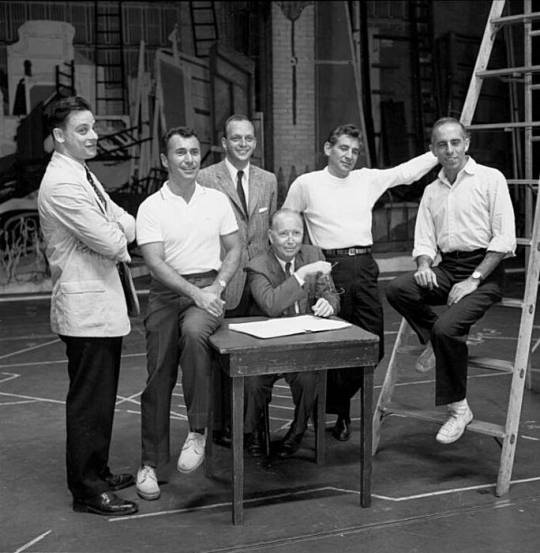
8 JULY 1957
New York, NY
Rehearsals begin.

20 AUGUST 1957
Washington D.C.
West Side Story opens in Washington D.C.

26 SEPTEMBER 1957
New York, NY
West Side Story opens on Broadway at the Winter Garden Theatre, runs for 732 performances.

1957
Original Broadway Cast Recording

13 APRIL 1958
Tony Awards
Best Choreographer (Jerome Robbins)
Best Scenic Designer (Oliver Smith)

18 OCTOBER 1961
United Artists motion picture released:
Directed by Robert Wise and Jerome Robbins
Starring Natalie Wood, Richard Beymer, Russ Tamblyn, Rita Moreno, and George Chakiris

1961
Film Soundtrack Recording
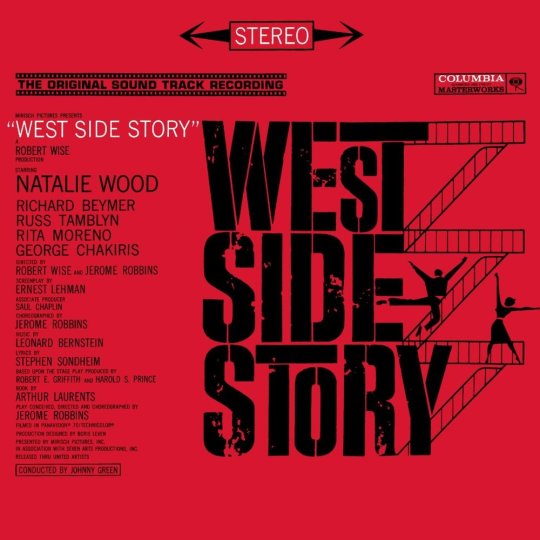
Reviews and Articles of West Side Story
THE NEW YORK TIMES
27 September 1957
Theatre: "West Side Story," The Jungles of the City
By BROOKS ATKINSON
Although the material is horrifying, the workmanship is admirable.
Gang warfare is the material of "West Side Story," which opened at the Winter Garden last evening, and very little of the hideousness has been left out. But the author, composer and ballet designer are creative artists. Pooling imagination and virtuosity, they have written a profoundly moving show that is as ugly as the city jungles and also pathetic, tender and forgiving.
Arthur Laurents has written the story of two hostile teen-age gangs fighting for supremacy amid the tenement houses, corner stores and bridges of the West Side. The story is a powerful one, partly, no doubt, because Mr. Laurents has deliberately given it the shape of "Romeo and Juliet." In the design of "West Side Story" he has powerful allies. Leonard Bernstein has composed another one of his nervous, flaring scores that capture the shrill beat of life in the streets. And Jerome Robbins, who has directed the production, is also its choreographer.
Since the characters are kids of the streets, their speech is curt and jeering. Mr. Laurents has provided the raw material of a tragedy that occurs because none of the young people involved understands what is happening to them. And his contribution is the essential one. But it is Mr. Bernstein and Mr. Robbins who orchestrate it. Using music and movement they have given Mr. Laurents' story passion and depth and some glimpses of unattainable glory. They have pitched into it with personal conviction as well as the skill of accomplished craftsmen.
In its early scenes of gang skirmishes, "West Side Story" is facile and a little forbidding -- the shrill music and the taut dancing movement being harsh and sinister. But once Tony of the Jets gang sees Maria of the Sharks gang, the magic of an immortal story takes hold. As Tony, Larry Kert is perfectly cast, plain in speech and manner; and as Maria, Carol Lawrence, maidenly soft and glowing, is perfectly cast also. Their balcony scene on the firescape of a dreary tenement is tender and affecting. From that moment on, "West Side Story" is an incandescent piece of work that finds odd bits of beauty amid the rubbish of the streets.
Everything in "West Side Story," is of a piece. Everything contributes to the total impression of wildness, ecstasy and anguish. The astringent score has moments of tranquility and rapture, and occasionally a touch of sardonic humor. And the ballets convey the things that Mr. Laurents is inhibited from saying because the characters are so inarticulate. The hostility and suspicion between the gangs, the glory of the nuptials, the terror of the rumble, the devastating climax -- Mr. Robbins has found the patterns of movement that express these parts of the story.
Most of the characters, in fact, are dancers with some images of personality lifted out of the whirlwind -- characters sketched on the wing. Like everything also in "West Side Story," they are admirable. Chita Rivera in a part equivalent to the nurse in the Shakespeare play; Ken Le Roy as leader of The Sharks; Mickey Calin as leader of The Jets; Lee Becker as a hobbledehoy girl in one gang -- give terse and vigorous performances.
Everything in "West Side Story" blends -- the scenery by Oliver Smith, the costumes by Irene Sharaff, the lighting by Jean Rosenthal. For this is one of those occasions when theatre people, engrossed in an original project, are all in top form. The subject is not beautiful. But what "West Side Story" draws out of it is beautiful. For it has a searching point of view.
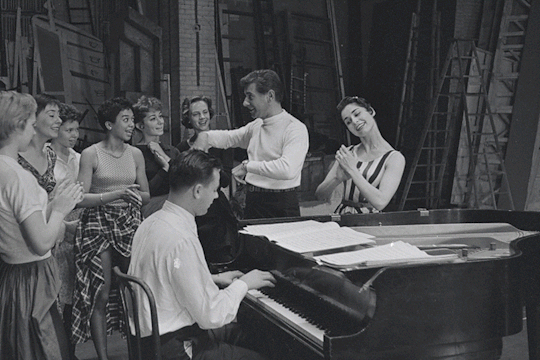
THE DAILY NEWS
27 September 1957
(Originally published by the Daily News on September 27, 1957. This story was written by John Chapman.)
‘West Side Story’ premieres on Broadway in 1957
BY JOHN CHAPMAN
The American theatre took a venturesome forward step when the firm of Griffith & Prince presented "West Side Story" at the Winter Garden last evening.
This is a bold new kind of musical theatre - a juke-box Manhattan opera. It is, to me, extraordinarily exciting. In it, the various fine skills of show business are put to new tests, and as a result a different kind of musical has emerged.
The story is, roughly, Shakespeare's recounting of the love and deaths of Romeo and Juliet. But the setting is today's Manhattan, and the manner of telling the story is a provocative and artful blend of music, dance and plot - and the music and the dancing are superb.
Superb Score
In this present-day version of the theatre's greatest romance, the Montagus and Capulets become young New York gangs, one white, the other Puerto Rican. The Romeo is a white boy, the Juliet a Puerto Rican girl. In the big fight switch-blade knives are used instead of swords. The apothecary who gave Romeo his fateful potion now is a mild druggist who mans his soda fountain and wonders what the younger generation is coming to. And the younger generation, even if it does indulge in one rumble which results in murder, is not nearly as blackhearted as current news stories might make us believe.
The music of "West Side Story" is by Leonard Bernstein, and it is superb - and splendidly played by an orchestra directed by Max Goberman. In it there is the drive, the bounce, the restlessness and the sweetness of our town. It takes up the American musical idiom where it was left when George Gershwin died. It is fascinatingly tricky and melodically beguiling, and it marks the progression of admirable composer.
The story, about the fundamentally innocent hoodlums of our town, is by Arthur Laurents, and it is a lovely and moving one. But Laurents is not alone in telling this story, for his collaborator is Jerome Robbins, the choreographer. Robbins and his superb young dancers carry the plot as much as the spoken words and lyrics do.
The lyrics, by Stephen Sondheim, have simple grace, and there is a lovely tribute by the sidewalk Romeo to his dusky girl, Maria. There is a really beautiful scene in which the boy and the girl go through a make believe wedding in a shop for bridal clothing. And there is an uproariously funny one in which a so-called juvenile delinquent gets a going-over by all the authorities whose problem he is - the cop, the judge, the social worker and the psychiatrist. This young hoodlum manages to make his elders look pretty silly.
Wonderful Cast
The cast of "West Side Story" is, next to the music, the best part of the production. It is composed of young people of whom few have been heard. Carol Lawrence and Larry Kert carry the love story with effortless simplicity, and they sing beautifully. There are other engaging performances by Chita Rivera, Mickey Calin, Ken Le Roy and Art Smith (the druggist). But the company itself is the star of the show. These boys and girls sing, dance and act with such skill and sincerity that they bring the audience out of its seats and up on the stage with them - and the stage is not a stage but this fascinating and fearful town of Manhattan.
And the settings by Oliver Smith and the costumes by Irene Sharaff are a perfect part of a perfect production.

NEW YORK HERALD TRIBUNE
27 September 1957
New York Herald Tribune, 9/27/57
Theater critic Walter Kerr wrote the following review of West Side Story for the New York Herald Tribune on September 27, 1957:
The radioactive fallout from "West Side Story" must still be descending on Broadway this morning.
Director, choreographer, and idea-man Jerome Robbins has put together, and then blasted apart, the most savage, restless, electrifying dance patterns we've been exposed to in a dozen seasons.
The curtain rises on a silence, and a pause. It is the last silence and the last pause. Against an empty-eyed background of warehouse windows five or six blue-jacketed young delinquents, with the tribal-mark "Jets" scrawled across their taut shoulders, are lounging, waiting for the first faint whisper of violence.
Their impatience comes to life in their fingers. A snapping rhythm begins to tap out a warning of mayhem to come. Knees begin to itch, and move, under the lazy, overcast mid-summer sky in Puerto-Rican New York.
The Sharks--equally young, equally sick with very old hatreds--appear from the alleyways in twos and threes. There is a sneer, a hiss, a tempting and tantalizing thrust of an arm, and then--with a powerhouse downbeat from the orchestra pit--the sorry and meaningless frenzy is on. From this moment the show rides with a catastrophic roar over the spider-web fire-escapes, the shadowed trestles, and the plain dirt battlegrounds of a big city feud.
Mr. Robbins never runs out of his original explosive life-force. Though the essential images are always the same--two spitting groups of people advancing with bared teeth and clawed fists upon one another--there is fresh excitement in the next debacle, and the next. When a gang leader advises his cohorts to play it "Cool," the intolerable tension between and effort at control and the instinctive drives of these potential killers is stingingly graphic. When the knives come out, and bodies begin to fly wildly through space under buttermilk clouds, the sheer visual excitement is breathtaking.
.[Robbins] has almost sacrificially assisted in this macabre and murderous onslaught of movement by composer Leonard Bernstein. Mr. Bernstein has permitted himself a few moments of graceful, lingering melody: in a yearning "Maria," in the hushed falling line of "Tonight," in the wistful declaration of "I Have a Love."
But for the most part he has served the needs of the onstage threshing machine, setting the fierce beat that fuses a gymnasium dance, putting a mocking insistence behind taunts at a policeman, dramatizing the footwork rather than lifting emotions into song. When hero Larry Kert is stomping out the visionary insistence of "Something's Coming" both music and tumultuous story are given their due. Otherwise it's the danced narrative that takes urgent precedence.

A Clip of a full description of the film and the actors thought on the film:
youtube
14 notes
·
View notes
Link
West Side Story is a 1961 American romantic musical drama film directed by Robert Wise and Jerome Robbins. The film is an adaptation of the 1957 Broadway musical of the same name, which in turn was inspired by William Shakespeare's play Romeo and Juliet. It stars Natalie Wood, Richard Beymer, Russ Tamblyn, Rita Moreno, and George Chakiris, and was photographed by Daniel L. Fapp in Super Panavision 70. Released on October 18, 1961, through United Artists, the film received high praise from critics and viewers, and became the second highest grossing film of the year in the United States. The film was nominated for 11 Academy Awards and won ten, including Best Picture (as well as a special award for Robbins), becoming the record holder for the most wins for a musical.
The film has been deemed "culturally significant" by the United States Library of Congress and was selected for the National Film Registry in 1997.[2]
Plot
In the summer of 1957 in the West Side's Lincoln Square neighborhood in Manhattan, there is tension between a white American gang, the Jets, led by Riff, and a Puerto Rican gang, the Sharks, led by Bernardo. After a brawl erupts, Lieutenant Schrank and Officer Krupke arrive and break it up. The Jets decide to challenge the Sharks to a rumble at an upcoming dance for neighborhood control.
Riff decides that his best friend Tony, the co-founder of the Jets who left the gang, should fight. Riff invites Tony to the dance, but Tony is uninterested. He tells Riff that he senses something important will happen, which Riff suggests could have a correlation with the dance.
Bernardo's younger sister, Maria, tells her best friend and Bernardo's girlfriend, Anita, how excited she is about the dance. At the dance, the gangs and girls refuse to intermingle. Tony arrives and he and Maria fall in love. However, Bernardo angrily demands that Tony stay away from her. Riff proposes a meeting with Bernardo at Doc's drug store.
Maria is sent home; Anita argues that Bernardo is overprotective of Maria and they compare the advantages of Puerto Rico and the United States.
Tony discreetly visits Maria on her fire escape, where they reaffirm their love. Krupke, who suspects the Jets are planning something, visits them and warns them not to cause trouble. When the Sharks arrive, both groups agree to have the showdown the following evening under the highway, with a one-on-one fist fight. When Schrank arrives, the gangs feign friendship. Schrank orders the Sharks out and unsuccessfully tries to discover information about the fight.
The next day at the bridal shop, Anita accidentally tells Maria about the rumble. Tony arrives to see Maria, which shocks Anita. They profess their love and Anita warns them about the consequences if Bernardo learns of their relationship. Maria has Tony promise to prevent the rumble. Tony and Maria fantasize about their wedding ceremony.
The Jets and Sharks approach the area under the highway. Tony arrives to stop the fight, but Bernardo antagonizes him. Unwilling to watch Tony be humiliated, Riff initiates a knife fight. Tony tries to intervene, which leads to Bernardo killing Riff. Tony kills Bernardo with Riff's knife and a melee ensues. Police sirens blare and everyone flees, leaving behind the dead bodies.
Maria waits for Tony on the rooftop of her apartment building when her fiancé Chino arrives and tells her what happened. Tony arrives and explains what transpired and asks for her forgiveness before he turns himself in to the police. Maria confirms her love for him and asks Tony to stay with her.
The Jets have reassembled outside a garage, with their new leader, Ice, having them focus on reacting to the police. Anybodys arrives and warns them that Chino is now after Tony. Ice sends the Jets to warn Tony.
Anita enters the apartment while Tony and Maria are in the bedroom. Tony and Maria arrange to meet at Doc's, where they will pick up getaway money to elope. Anita spots Tony leaving through the window and chides Maria for the relationship, but Maria convinces her to help them elope.
Schrank arrives and questions Maria about the rumble. To cover for Tony, Maria has Anita tell him that Maria is detained from meeting him. When Anita reaches Doc's, the Jets harass her, until Doc intervenes. Anita declares that Bernardo was right about them and that Chino killed Maria. Doc banishes the Jets and gives Tony his getaway money in the basement and delivers Anita's message. Tony runs into the streets, shouting for Chino to kill him as well.
In the playground next to Doc's, Tony spots Maria and they run toward each other, only for Chino to shoot Tony. The Jets and Sharks arrive to find Maria holding Tony, who dies in her arms. Maria stops the gangs from fighting, takes the gun from Chino and threatens to shoot everyone, blaming their hate for the deaths. Schrank, Krupke and Doc arrive and the gangs form a funeral procession, with Maria following. The police arrest Chino and lead him away.
Cast
Natalie Wood as Maria, Bernardo's younger sister, and Chino's arranged fiancée, who falls in love with Tony
Richard Beymer as Tony, co-founder and one-time member of the Jets, but remains the best friend of Riff; works at Doc's drug store, and becomes Maria's star-crossed lover
Russ Tamblyn as Riff, leader of the Jets, best friend of Tony
Rita Moreno as Anita, Bernardo's girlfriend, and Maria's closest confidante
George Chakiris as Bernardo, leader of the Sharks, older brother of Maria and Anita's boyfriend
Simon Oakland as Police Lieutenant Schrank, a hard-boiled plainclothes detective
William Bramley as Police Sergeant Krupke, a brusque beat cop. Bramley reprises his role from the original Broadway production.
Ned Glass as Doc, drugstore owner, Tony's boss; a decent, elderly man
Marni Nixon as Maria's singing voice
Jimmy Bryant as Tony's singing voice
Tucker Smith as Ice and as Riff's singing voice for "Jet Song" (Tamblyn did his own singing for "Gee, Officer Krupke!" and "Quintet")
Betty Wand as Anita's singing voice for "A Boy Like That" (Moreno did her own singing for "America" and "Quintet")
Uncredited
John Astin as Glad Hand, well-meaning but ineffective social worker
Penny Santon as Madam Lucia, bridal shop owner
Jets
Tucker Smith as Ice (a character created for the film), Riff's lieutenant; becomes leader of the Jets after Riff's death
Tony Mordente as Action, a short-tempered Jet.
Eliot Feld as Baby John, the youngest member of the Jets; a relative innocent
David Winters as A-Rab, Baby John's closest friend
Bert Michaels as Snowboy
David Bean as Tiger
Robert Banas as Joyboy
Anthony 'Scooter' Teague as Big Deal
Harvey Evans (Harvey Hohnecker) as Mouthpiece
Tommy Abbott as Gee-Tar
Jet Girls
Susan Oakes as Anybodys, a tomboy and wannabe Jet
Gina Trikonis as Graziella, Riff's girlfriend.
Carole D'Andrea as Velma, Ice's girlfriend
Uncredited
Rita Hyde d'Amico as Clarice, Big Deal's girlfriend
Pat Tribble as Minnie, Baby John's girlfriend
Francesca Bellini as Debby, Snowboy's girlfriend
Elaine Joyce as Hotsie, Tiger's girlfriend
Sharks
Jose De Vega [it] as Chino Martin, Bernardo's best friend
Jay Norman as Pepe, Bernardo's lieutenant
Gus Trikonis as Indio, Pepe's best friend
Eddie Verso as Juano
Jaime Rogers as Loco
Larry Roquemore as Rocco
Robert Thompson as Luis
Nick Covacevich as Toro
Rudy Del Campo as Del Campo
Andre Tayir as Chile
Shark Girls
Yvonne (Othon) Wilder as Consuelo, Pepe's girlfriend
Suzie Kaye as Rosalia, Indio's girlfriend
Joanne Miya as Francisca, Toro's girlfriend
Uncredited
Maria Jimenez Henley as Teresita, Juano's girlfriend
Yvonne (Othon) Wilder as Alicia, Chile's girlfriend
Luci Stone as Estella, Loco's girlfriend
Olivia Perez as Margarita, Rocco's girlfriend
0 notes